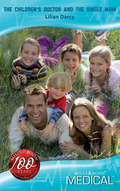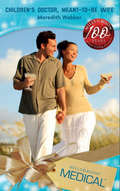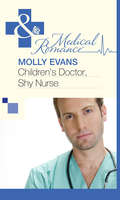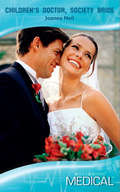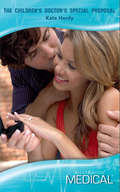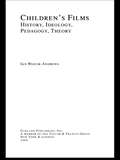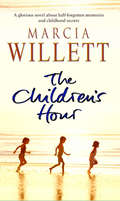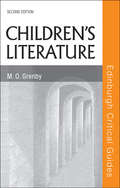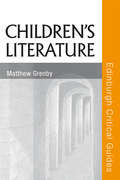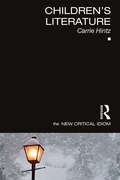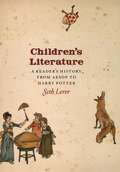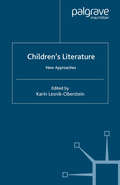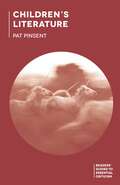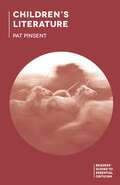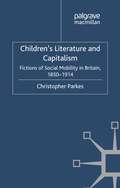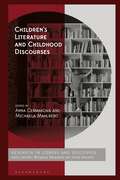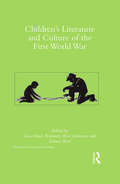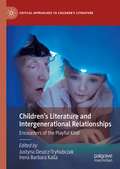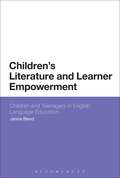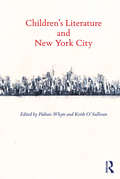- Table View
- List View
The Children's Doctor and the Single Mum (Mills And Boon Medical Ser.)
by Lilian DarcyEnter into the world of high-flying Doctors as they navigate the pressures of modern medicine and find escape, passion, comfort and love – in each other’s arms! The doctor takes a family!
Children's Doctor, Meant-to-be Wife: Marrying The Millionaire Doctor / Children's Doctor, Meant-to-be Wife / A Bride And Child Worth Waiting For (Crocodile Creek #3)
by Meredith WebberEnter into the world of high-flying Doctors as they navigate the pressures of modern medicine and find escape, passion, comfort and love – in each other’s arms! Top-Notch Doc, Top-Notch Husband
Children's Doctor, Shy Nurse (Mills And Boon Medical Ser.)
by Molly EvansDr Mark Collins feels he's on borrowed time, and is determined to make the most of his new job. Timid nurse Ellie Mackenzie has the same idea – until she meets Mark, her new boss! As work forces their lives to intertwine, it's clear they each hold the key to healing the other's heart…
Children's Doctor, Society Bride: Posh Doc Claims His Bride / Surgeon Boss, Surprise Dad / Children's Doctor, Society Bride / The Royal Doctor's Bride / The Doctor Claims His Bride / The Rebel Surgeon's Proposal (Mills And Boon Medical Ser.)
by Joanna NeilMillionaire doctor: wife wanted! Dr Louise Bridgford is devoted to her job on a busy A&E children’s ward. Although her tireless work leaves her little time for romance, she can’t help noticing the devastatingly handsome Dr James Ashleigh – also known as the next Lord Ashleigh!
The Children's Doctor's Special Proposal: The Secret Wedding Dress / The Millionaire's Marriage Claim / The Children's Doctor's Special Proposal (The London Victoria #2)
by Kate HardyA special bride for a special doctor
Children's Films: History, Ideology, Pedagogy, Theory (Children's Literature and Culture)
by Ian Wojik-AndrewsThis study examines children's films from various critical perspectives, including those provided by classical and current film theory.
Children's Films: History, Ideology, Pedagogy, Theory (Children's Literature and Culture)
by Ian Wojik-AndrewsThis study examines children's films from various critical perspectives, including those provided by classical and current film theory.
The Children's Hour: A Novel
by Marcia WillettNest and Mina still live at Ottercombe, their beautiful old rambling childhood home in the depths of Devon. They came to the house before the war, when as small children they played with their sisters and brothers in the gardens and the woods and the nearby beach while their mother read them stories and their father visited at weekends. It was, in retrospect, an idyllic time, when tragedy seemed far distant. Now they welcome their children and grandchildren , and especially young Lyddie, their niece, who lives in Cornwall with her handsome husband Liam. But when their sister Georgie, now somewhat frail and forgetful, comes to stay with them, aspects of their past start to revisit them. For Georgie knows all their secrets, secrets which she wants to share...A glorious novel about half-forgotten memories and childhood secrets in the tradition of Rosamunde Pilcher, and perfect for fans of Victoria Hislop, Erica James and Santa Montefiore
Children's Literature (Edinburgh Critical Guides to Literature)
by M. O. GrenbyProvides a thorough history of British and North American children’s literature from the 17th century to the present day Now fully revised and updated, this new edition includes: • a new chapter on illustrated and picture books (and includes 8 illustrations);• an expanded glossary;• an updated further reading section. Children’s Literature traces the development of the main genres of children’s books one by one, including fables, fantasy, adventure stories, moral tales, family stories, school stories, children’s poetry and illustrated and picture books. Grenby shows how these forms have evolved over 300 years and asks why most children’s books, even today, continue to fall into one or other of these generic categories. Combining detailed analysis of particular key texts and a broad survey of hundreds of books written and illustrated for children, this volume considers both long forgotten and still famous titles, as well as the new classics of the genre †“ all of them loved by children and adults alike, but also fascinating and challenging for the critic and cultural historian. Key Features • Broad historical range• Coverage of neglected as well as well-known texts• Focus on the main genres of children’s literature• Thoroughly up-to-date in terms of primary texts and critical material
Children's Literature (Edinburgh Critical Guides to Literature)
by M. O. GrenbyProvides a thorough history of British and North American children’s literature from the 17th century to the present day Now fully revised and updated, this new edition includes: • a new chapter on illustrated and picture books (and includes 8 illustrations);• an expanded glossary;• an updated further reading section. Children’s Literature traces the development of the main genres of children’s books one by one, including fables, fantasy, adventure stories, moral tales, family stories, school stories, children’s poetry and illustrated and picture books. Grenby shows how these forms have evolved over 300 years and asks why most children’s books, even today, continue to fall into one or other of these generic categories. Combining detailed analysis of particular key texts and a broad survey of hundreds of books written and illustrated for children, this volume considers both long forgotten and still famous titles, as well as the new classics of the genre †“ all of them loved by children and adults alike, but also fascinating and challenging for the critic and cultural historian. Key Features • Broad historical range• Coverage of neglected as well as well-known texts• Focus on the main genres of children’s literature• Thoroughly up-to-date in terms of primary texts and critical material
Children's Literature (The New Critical Idiom)
by Carrie HintzChildren’s Literature is an accessible introduction to this engaging field. Carrie Hintz offers a defining conceptual overview of children’s literature that presents its competing histories, its cultural contexts, and the theoretical debates it has instigated. Positioned within the wider field of adult literary, film, and television culture, this book also covers: Ideological and political movements Children’s literature in the age of globalization Postcolonial literature, ecocriticism, and animal studies Each chapter includes a case study featuring well-known authors and titles, including Charlotte’s Web, Edward Lear, and Laura Ingalls Wilder. With a comprehensive glossary and further reading, this book is invaluable reading for anyone studying Children’s Literature.
Children's Literature (The New Critical Idiom)
by Carrie HintzChildren’s Literature is an accessible introduction to this engaging field. Carrie Hintz offers a defining conceptual overview of children’s literature that presents its competing histories, its cultural contexts, and the theoretical debates it has instigated. Positioned within the wider field of adult literary, film, and television culture, this book also covers: Ideological and political movements Children’s literature in the age of globalization Postcolonial literature, ecocriticism, and animal studies Each chapter includes a case study featuring well-known authors and titles, including Charlotte’s Web, Edward Lear, and Laura Ingalls Wilder. With a comprehensive glossary and further reading, this book is invaluable reading for anyone studying Children’s Literature.
Children's Literature: A Reader's History, from Aesop to Harry Potter
by Seth LererEver since children have learned to read, there has been children’s literature. Children’s Literature charts the makings of the Western literary imagination from Aesop’s fables to Mother Goose, from Alice's Adventures in Wonderland to Peter Pan, from Where the Wild Things Are to Harry Potter. The only single-volume work to capture the rich and diverse history of children’s literature in its full panorama, this extraordinary book reveals why J. R. R. Tolkien, Dr. Seuss, Laura Ingalls Wilder, Beatrix Potter, and many others, despite their divergent styles and subject matter, have all resonated with generations of readers. Children’s Literature is an exhilarating quest across centuries, continents, and genres to discover how, and why, we first fall in love with the written word. “Lerer has accomplished something magical. Unlike the many handbooks to children’s literature that synopsize, evaluate, or otherwise guide adults in the selection of materials for children, this work presents a true critical history of the genre. . . . Scholarly, erudite, and all but exhaustive, it is also entertaining and accessible. Lerer takes his subject seriously without making it dull.”—Library Journal (starred review) “Lerer’s history reminds us of the wealth of literature written during the past 2,600 years. . . . With his vast and multidimensional knowledge of literature, he underscores the vital role it plays in forming a child’s imagination. We are made, he suggests, by the books we read.”—San Francisco Chronicle “There are dazzling chapters on John Locke and Empire, and nonsense, and Darwin, but Lerer’s most interesting chapter focuses on girls’ fiction. . . . A brilliant series of readings.”—Diane Purkiss, Times Literary Supplement
Children’s Literature: New Approaches
by K. Lesnik-ObersteinChildren's Literature: New Approaches is a guide for graduate and upper-level undergraduate students of children's literature. It is structured through critics reading individual texts to bring out wider issues that are current in the field. Includes chronology of key events and publications, a selective guide to further reading and a list of Web-based resources.
Children's Literature (Readers' Guides to Essential Criticism)
by Pat PinsentThis invaluable Guide surveys the key critical works and debates in the vibrant field of children's literature since its inception. Leading expert Pat Pinsent combines a chronological overview of developments in the genre with analysis of key theorists and theories, and subject-specific methodologies.
Children's Literature (Readers' Guides to Essential Criticism)
by Pat PinsentThis invaluable Guide surveys the key critical works and debates in the vibrant field of children's literature since its inception. Leading expert Pat Pinsent combines a chronological overview of developments in the genre with analysis of key theorists and theories, and subject-specific methodologies.
Children's Literature and Capitalism: Fictions of Social Mobility in Britain, 1850-1914 (Critical Approaches to Children's Literature)
by C. ParkesAfter the first phase of industrialization in Britain, the child emerged as both a victim of and a threat to capitalism. This book explores the changing relationship between the child and capitalist society in the works of some of the most important writers of children's and young-adult texts in the Victorian and Edwardian periods.
Children’s Literature and Childhood Discourses: Exploring Identity through Fiction (Corpus and Discourse)
by Anna Cermakova and Michaela MahlbergChildren's literature shapes what children learn about the world. It reflects social values, norms, and stereotypes. This book offers fresh insights into some of the key issues in fiction for children, from the representation of gender to embodied cognition and the translation of children's literature.Connecting classic children's texts such as Alice in Wonderland with contemporary fiction including Murder Most Unladylike, the book innovatively brings together perspectives from corpus linguistics, stylistics, cognitive linguistics, literary and cultural studies, and human geography. It explores approaches to experiencing fiction, as well as methods for the study of literary texts. Childhood discourses are investigated through the materiality of texts, the spaces that literature takes up in libraries, the cultural history of fiction moulded through performances, as well as reading environments that shape childhood experiences, such as fashion and urban spaces.Children's Literature and Childhood Discourses emphasizes the crucial link between fictional stories and real life.
Children’s Literature and Childhood Discourses: Exploring Identity through Fiction (Corpus and Discourse)
Children's literature shapes what children learn about the world. It reflects social values, norms, and stereotypes. This book offers fresh insights into some of the key issues in fiction for children, from the representation of gender to embodied cognition and the translation of children's literature.Connecting classic children's texts such as Alice in Wonderland with contemporary fiction including Murder Most Unladylike, the book innovatively brings together perspectives from corpus linguistics, stylistics, cognitive linguistics, literary and cultural studies, and human geography. It explores approaches to experiencing fiction, as well as methods for the study of literary texts. Childhood discourses are investigated through the materiality of texts, the spaces that literature takes up in libraries, the cultural history of fiction moulded through performances, as well as reading environments that shape childhood experiences, such as fashion and urban spaces.Children's Literature and Childhood Discourses emphasizes the crucial link between fictional stories and real life.
Children's Literature and Culture of the First World War (Children's Literature and Culture)
by Emma Short Lissa Paul Rosemary R. JohnstonBecause all wars in the twenty-first century are potentially global wars, the centenary of the first global war is the occasion for reflection. This volume offers an unprecedented account of the lives, stories, letters, games, schools, institutions (such as the Boy Scouts and YMCA), and toys of children in Europe, North America, and the Global South during the First World War and surrounding years. By engaging with developments in Children’s Literature, War Studies, and Education, and mining newly available archival resources (including letters written by children), the contributors to this volume demonstrate how perceptions of childhood changed in the period. Children who had been constructed as Romantic innocents playing safely in secure gardens were transformed into socially responsible children actively committing themselves to the war effort. In order to foreground cross-cultural connections across what had been perceived as ‘enemy’ lines, perspectives on German, American, British, Australian, and Canadian children’s literature and culture are situated so that they work in conversation with each other. The multidisciplinary, multinational range of contributors to this volume make it distinctive and a particularly valuable contribution to emerging studies on the impact of war on the lives of children.
Children's Literature and Culture of the First World War (Children's Literature and Culture)
by Emma Short Lissa Paul Rosemary Ross JohnstonBecause all wars in the twenty-first century are potentially global wars, the centenary of the first global war is the occasion for reflection. This volume offers an unprecedented account of the lives, stories, letters, games, schools, institutions (such as the Boy Scouts and YMCA), and toys of children in Europe, North America, and the Global South during the First World War and surrounding years. By engaging with developments in Children’s Literature, War Studies, and Education, and mining newly available archival resources (including letters written by children), the contributors to this volume demonstrate how perceptions of childhood changed in the period. Children who had been constructed as Romantic innocents playing safely in secure gardens were transformed into socially responsible children actively committing themselves to the war effort. In order to foreground cross-cultural connections across what had been perceived as ‘enemy’ lines, perspectives on German, American, British, Australian, and Canadian children’s literature and culture are situated so that they work in conversation with each other. The multidisciplinary, multinational range of contributors to this volume make it distinctive and a particularly valuable contribution to emerging studies on the impact of war on the lives of children.
Children’s Literature and Intergenerational Relationships: Encounters of the Playful Kind (Critical Approaches to Children's Literature)
by Justyna Deszcz-Tryhubczak Irena Barbara KallaChildren’s Literature and Intergenerational Relationships: Encounters of the Playful Kind explores ways in which children’s literature becomes the object and catalyst of play that brings younger and older generations closer to one another. Providing examples from diverse cultural and historical contexts, this collection argues that children’s texts promote intergenerational play through the use of literary devices and graphic formats and that they may prompt joint play practices in the real world. The book offers a distinctive contribution to children’s literature scholarship by shifting critical attention away from the difference and conflict between children and adults to the exploration of inter-age interdependencies as equally crucial aspects of human life, presenting a new perspective for all who research and work with children’s culture in times of global aging.
Children's Literature and Learner Empowerment: Children and Teenagers in English Language Education
by Janice BlandChildren's literature can be a powerful way to encourage and empower EFL students but is less commonly used in the classroom than adult literature. This text provides a comprehensive introduction to children's and young adult literature in EFL teaching. It demonstrates the complexity of children's literature and how it can encourage an active community of second language readers: with multilayered picturebooks, fairy tales, graphic novels and radical young adult fiction. It examines the opportunities of children's literature in EFL teacher education, including: the intertexuality of children's literature as a gate-opener for canonised adult literature; the rich patterning of children's literature supporting Creative Writing; the potential of interactive drama projects. Close readings of texts at the centre of contemporary literary scholarship, yet largely unknown in the EFL world, provide an invaluable guide for teacher educators and student teachers, including works by David Almond, Anthony Browne, Philip Pullman and J.K.Rowling. Introducing a range of genres and their significance for EFL teaching, this study makes an important new approach accessible for EFL teachers, student teachers and teacher educators.
Children's Literature and Learner Empowerment: Children and Teenagers in English Language Education
by Janice BlandChildren's literature can be a powerful way to encourage and empower EFL students but is less commonly used in the classroom than adult literature. This text provides a comprehensive introduction to children's and young adult literature in EFL teaching. It demonstrates the complexity of children's literature and how it can encourage an active community of second language readers: with multilayered picturebooks, fairy tales, graphic novels and radical young adult fiction. It examines the opportunities of children's literature in EFL teacher education, including: the intertexuality of children's literature as a gate-opener for canonised adult literature; the rich patterning of children's literature supporting Creative Writing; the potential of interactive drama projects. Close readings of texts at the centre of contemporary literary scholarship, yet largely unknown in the EFL world, provide an invaluable guide for teacher educators and student teachers, including works by David Almond, Anthony Browne, Philip Pullman and J.K.Rowling. Introducing a range of genres and their significance for EFL teaching, this study makes an important new approach accessible for EFL teachers, student teachers and teacher educators.
Children's Literature and New York City (Children's Literature and Culture)
by Padraic Whyte Keith O'SullivanThis collection explores the significance of New York City in children’s literature, stressing literary, political, and societal influences on writing for young people from the twentieth century to the present day. Contextualized in light of contemporary critical and cultural theory, the chapters examine the varying ways in which children’s literature has engaged with New York City as a city space, both in terms of (urban) realism and as an ‘idea’, such as the fantasy of the city as a place of opportunity, or other associations. The collection visits not only dominant themes, motifs, and tropes, but also the different narrative methods employed to tell readers about the history, function, physical structure, and conceptualization of New York City, acknowledging the shared or symbiotic relationship between literature and the city: just as literature can give imaginative ‘reality’ to the city, the city has the potential to shape the literary text. This book critically engages with most of the major forms and genres for children/young adults that dialogue with New York City, and considers such authors as Margaret Wise Brown, Felice Holman, E. L. Konigsburg, Maurice Sendak, J. D. Salinger, John Donovan, Shaun Tan, Elizabeth Enright, and Patti Smith.
